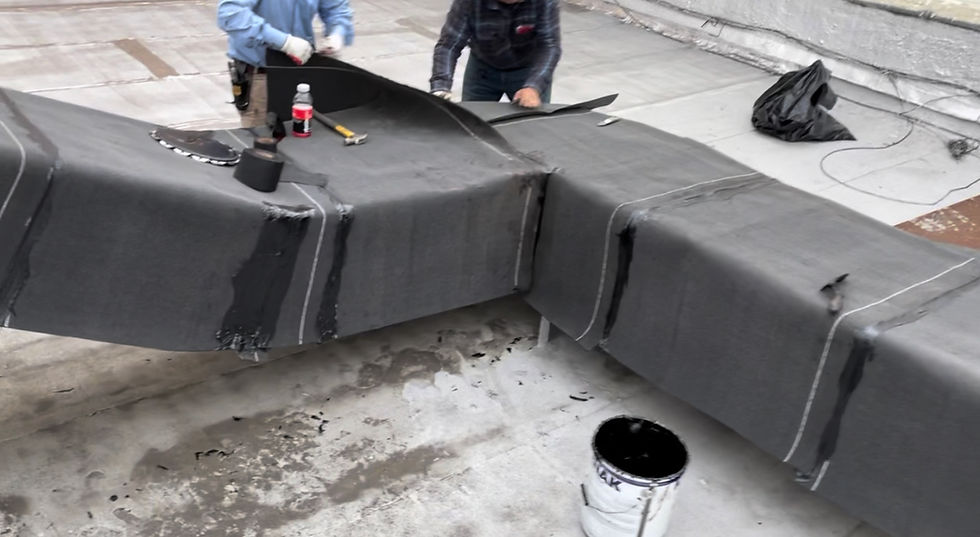HVAC Leaks
- M K

- Sep 10, 2023
- 4 min read
HVAC units are one of the most common causes of leaks in a building. Usually you can identify an HVAC leak when you see water dripping out of or around one of the parts associated with an HVAC unit. Possible HVAC leaks include water leaking down the sides or out of the duct work, water dripping from the pipes associated with the HVAC unit or from the point where the pipes penetrate the roof. Water dripping out of or around the HVAC vents.
Solving HVAC leaks can be difficult as it can be hard to determine whether the leak is caused by a roof issue or an HVAC issue. It's common for both HVAC companies to say its a roofing issue and for Roofers to say its an HVAC issue leaving a commercial building owner/manager confused as to what to do next to address the leak. In this blog post we will try and give you some tips to help you figure out whether it is a roofing issue or an HVAC issue, so you can know who to contact and how to best address the leak.
Finding the Cause:
The first important thing to check before calling anyone is when exactly does the leak occur.

If the leak occurs when its not raining then its most likely a condensation/HVAC issue. Just like when you take a cold soda can out in hot weather droplets begin to form on the outside, an HVAC system that is cold from blowing cold air, can form droplets on the outside of the cold ductwork, or the cold pipes.
HVAC ducts or pipes that are condensating are usually not insulated properly. Insulating them helps to keep the warm air in your building from touching the cold ducts/pipes thereby creating moisture.

Sometimes your HVAC pipes can even get so cold that they will form ice on them. When the ice melts it creates a leak. Ice forming on the pipes is usually a result of low levels of freon or a dirty air filter.
If your leak is occurring when its not raining we suggest calling an HVAC contractor.
If the leak occurs only when it's raining, it's likely that the leak is caused by a failure in the waterproofing/seal of the roof or in the HVAC unit. This can be a failure in the roofing membrane around the unit causing water to enter the building in that area, or it can be a failure in the HVAC system such as an opening in the rooftop ductwork, or a cracked/rusted drip pan allowing rainwater to enter the system. Most of the time if it only leaks when it rains a roofer is the better option and can usually address the problem.
Repairing the Issue:
Once you figure out the leak is caused by a waterproofing/roofing issue you can begin to search for the failure in your system. The most common places to check will be
The roofing flashing/waterproofing around where your HVAC duct penetrates your roof.

Sometimes the roof membrane around the base of the duct will be failing allowing water into the system. The photo above shows a duct entering the building from the roof. If you have a leak in this area you should inspect the membrane and flashing for open seams and cracks. This can be repaired using flashing cement to seal any openings.
2. The area where there HVAC pipes penetrate the roof. This area is normally sealed using a product called a pitch pocket. A pitch pocket is a small raised box (pocket) with pipes running through it that is filled with sealant to waterproof them.

Sometimes the sealant inside the pitch pocket shrinks and cracks over time. In this case the pocket just needs to be topped off with a new layer of sealant to fill it up and close the cracks.
If your pipes penetrate the roof without a pitch pocket it's advisable to add one. A pitch pocket is a superior method of waterproofing your pipes as it add 2-4 inches of sealant and can seal in between pipes that are close together.

3. Openings in your ductwork that is allowing water inside the system.

Sometimes the rooftop ductwork can have seams that arn't closed properly, or even exposed punctures such as screw holes or rust holes that allow rainwater into the duct that then runs through the ductwork and leaks out of it inside the building.
The photo on the left show an open seam in the ductwork large enough for a trowel to slide inside. Many times the openings are smaller and even small screw holes in the ductwork can allow water to enter. Usually we like to address issues like this by wrapping the ducts in waterproofing membrane. This prevents water from getting into the open seams or other openings.

This photo on the right shows us waterproofing leaking ductwork by wrapping it in membrane.
Although these are the most common waterproofing failures when it comes to HVAC leaks there are other less common failures that can cause leaks in your building.
Conclusion:
HVACs are one of the most popular causes of roof leaks. As a building owner/manager, diagnosing and repairing these leaks can be a challenging task. It's always best to call a professional to help diagnose and repair your roof leaks.


Comments